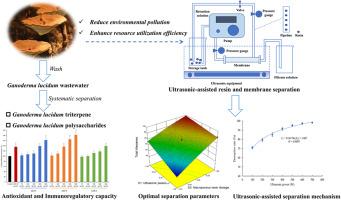超声辅助大孔树脂-膜工艺系统分离灵芝废水
IF 5.8
2区 化学
Q2 CHEMISTRY, MULTIDISCIPLINARY
引用次数: 0
摘要
为了减少灵芝废水排放对环境的污染,同时降低制药企业的生产成本,提高资源利用效率,本研究提供了一种系统的超声辅助分离灵芝三萜和多糖的方法。第一步改进了多糖、三萜和低聚糖的分离。最佳分离参数为超声功率600 W、pH 6.20、树脂投加量3倍。废水处理量从2 L提高到50 L,对三萜的吸附率为91.34% ~ 97.63%,对灵芝酸A的吸附率为85.62% ~ 92.76%,对低聚糖的去除率为42.08% ~ 38.96%。第二步涉及使用超声波辅助纳滤分离三萜。超声功率600 W, 60%乙醇溶液,300-500 Da纳滤条件下,三萜得率为95.06%。此外,超声功率与三萜解吸效率之间存在很强的对数关系。第三步采用超滤法对灵芝多糖进行系统分离。从10 L灵芝废水中提取10 kDa - 30 kDa多糖(GLP-1)为116.5 mg, 30 kDa - 50 kDa多糖(GLP-2)为404.2 mg, 50 kDa以上多糖(GLP-3)为619.3 mg。与GLP-1和GLP-3相比,GLP-2具有更强的抗氧化和免疫调节活性。超声波辅助分离技术解决了灵芝废水中药物资源回收的工艺难题,实现了灵芝三萜和多糖的有序分离。本文章由计算机程序翻译,如有差异,请以英文原文为准。

Ultrasonic-assisted macroporous resin and membrane processes for the systematic separation of Ganoderma lucidum wastewater
To reduce environmental pollution caused by Ganoderma lucidum wastewater discharge while also decreasing pharmaceutical business manufacturing costs and improving resource utilization efficiency, this study provides a systematic method for ultrasonic assisted separation of Ganoderma lucidum triterpenes and polysaccharides. The first step improved the separation of polysaccharides, triterpenes, and oligosaccharides. The optimal separation parameters were 600 W of ultrasonic power, pH 6.20, and resin dosage 3 times. The wastewater treatment volume was raised from 2 L to 50 L, the adsorption rates of triterpene ranged from 91.34 % to 97.63 %, Ganoderma acid A ranged from 85.62 % to 92.76 %, and the oligosaccharides removal rate ranged from 42.08 % to 38.96 %, respectively. The second step involved the use of ultrasonic-assisted nanofiltration for separating triterpenes. 600 W of ultrasonic power, 60 % ethanol solution, and 300–500 Da nanofiltration were the separation conditions, and the triterpene yield was 95.06 %. Additionally, there is a strong logarithmic relationship between ultrasonic power and triterpene desorption efficiency. The third step involved the systematic separation of the Ganoderma lucidum polysaccharide by ultrafiltration. 116.5 mg of 10 kDa–30 kDa polysaccharide (GLP-1), 404.2 mg of 30 kDa–50 kDa polysaccharide (GLP-2), and 619.3 mg of more than 50 kDa polysaccharide (GLP-3) were obtained from 10 L of Ganoderma lucidum wastewater. And GLP-2 has greater antioxidant and immunomodulatory activity than GLP-1 and GLP-3. The ultrasonic assisted separation technology solves the technological problem of recycling medicine resources of Ganoderma lucidum wastewater, achieves the orderly separation of Ganoderma lucidum triterpenes and polysaccharides.
求助全文
通过发布文献求助,成功后即可免费获取论文全文。
去求助
来源期刊

Sustainable Chemistry and Pharmacy
Environmental Science-Pollution
CiteScore
8.20
自引率
6.70%
发文量
274
审稿时长
37 days
期刊介绍:
Sustainable Chemistry and Pharmacy publishes research that is related to chemistry, pharmacy and sustainability science in a forward oriented manner. It provides a unique forum for the publication of innovative research on the intersection and overlap of chemistry and pharmacy on the one hand and sustainability on the other hand. This includes contributions related to increasing sustainability of chemistry and pharmaceutical science and industries itself as well as their products in relation to the contribution of these to sustainability itself. As an interdisciplinary and transdisciplinary journal it addresses all sustainability related issues along the life cycle of chemical and pharmaceutical products form resource related topics until the end of life of products. This includes not only natural science based approaches and issues but also from humanities, social science and economics as far as they are dealing with sustainability related to chemistry and pharmacy. Sustainable Chemistry and Pharmacy aims at bridging between disciplines as well as developing and developed countries.
 求助内容:
求助内容: 应助结果提醒方式:
应助结果提醒方式:


